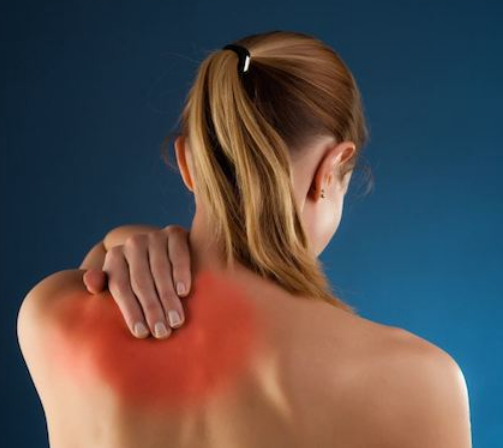
Although lower back pain is more common, more people are encountering issues due to prolonged sitting and upper back pain. There are many reasons why such pain may develop including injury or muscle strain, but this issue is growing more prevalent due to lifestyle. As more people spend time in front of a computer or smart phone, poor posture has become more common. A more sedentary lifestyle in which your spine and muscles are contorted into unnatural positions for long periods of time can raise your susceptibility to upper back pain.
Back pain issues are some of the most common health conditions in the U.S. It is estimated that 80 percent of all Americans will experience back problems at some point in their life. Women are more likely to develop back problems than men, presumably due to the rigors of childbirth and child rearing. Unlike lower back pain problems which are more common as you age, upper back issues tend to appear more among adolescents than other age groups.
How Your Upper Back Differs from Your Lower Back
Your upper back includes 12 vertebrae (bones in your spine), known as the thoracic spinal region. Unlike the cervical spine (neck) or lumbar spine (lower back), your upper back is fairly rigid. This rigidity is due to connections to ribs on either side which limit mobility. Although your neck and lower back are intended to bend and twist making them more susceptible to injury, your upper back is less vulnerable to those conditions.
The structural differences may mean that upper back pain issues are less likely to develop because there is less mobility in the thoracic spinal region, but the differences also mean that surgical options for pain management are more limited. This is primarily because the joints with the ribs make it more difficult for surgeons to access and manipulate spinal structures. The presence of the heart and lungs also make an upper spinal surgery riskier.
Common Upper Back Pain Conditions
There are many health conditions which may produce upper back pain, including:
- Traumatic injury—one of the most common upper back pain conditions is related to an injury like those resulting from a vehicle accident. Although the thoracic spine is relatively strong, a powerful enough collision may still damage the muscle, bone, connective tissue or nerves found in this area. A fracture to a vertebra or a misalignment can produce intense pain if it produces pressure on a nerve.
- Osteoporosis—a bone fracture may also result from weakened bones in the spine. More than 54 million Americans—mostly Americans over 50—have osteoporosis, which can eat away at bone strength. One of the key symptoms of osteoporosis is a stooped upper back which produces additional strain on muscles and ligaments in the area.
- Spinal epidural abscess—an infection may also produce a deposit of pus that presses on the spinal cord. This often produces intense pain in the upper back as well as other symptoms like fever and leg paralysis. Without medical intervention, a spinal epidural abscess can be fatal.
- Poor posture—long periods of time in an unnatural sitting position may produce upper back pain. Over a long enough period of time, this poor posture may lead to structural changes in the upper back and neck. Improper spinal alignment can apply more pressure on discs, muscles and nerves, causing pain and discomfort.
- Herniated disc—a common cause of upper back pain is a herniated disc. These spinal discs are found between thoracic vertebrae and serve as cushions between bones. A herniated disc may involve a torn or misaligned disc that applies pressure on a nerve. Although herniated discs in the upper back are common, they rarely cause pain. The most likely cause of herniated discs is spinal degeneration due to age.
- Arthritis—another common health condition that can produce upper back pain is arthritis. Various forms of arthritis may wear away the discs that cushion upper spinal vertebrae. This may allow bones to rub against one another, producing bone fragments that can be very painful.
- Spinal deformity—in its natural form, your thoracic spine should curve outward slightly, but deformation due to scoliosis or Scheuermann’s kyphosis may distend the spine. This places extreme strain on bones and nerves as well as on some organs. This painful condition can be rectified using back braces or physical therapy.
- Fibromyalgia—it is fairly common for fibromyalgia sufferers to experience pain in the upper back. Unlike other upper back conditions, fibromyalgia is not a degenerative health condition.
Upper Back Pain Management Treatment Options
If your upper back pain continues, then there are some steps you can take to manage it, including:
- Over-the-counter pain relievers—you are likely to try an over-the-counter pain reliever almost immediately to treat any kind of back pain, but you may not realize that drugs like aspirin, ibuprofen or acetaminophen may be as or more effective than prescription medications.
- Bed rest—another common sense reaction to upper back pain is to limit your activities. You may want to take one or two days in bed to help reduce the pain, but any more than that may be counter-productive. Too much bed rest may actually weaken your back muscles, prolonging your pain or raising your risk of another injury.
- Exercise—regular trips to the gym, walks or stretches can not only help loosen up tense muscles, but regular exercise can strengthen your back and promote your body’s natural ability to produce pain killers. Prolonged exercise has also been shown to increase the tolerance for pain, making upper back pain less disruptive.
- Improve your posture—if you find yourself assuming a bad posture, then make it a priority to sit in an optimal position with your head, shoulders and hips in alignment. If you sit for long periods, make a habit of standing, stretching or taking short walks every hour to relieve tension in your upper back.
- Stop smoking—smoking poses many health risks, but it may cause back pain by limiting flow of oxygen and nutrients to your spine.
Article written by: Dr. Robert Moghim – CEO/Founder Colorado Pain Care
M.D. Disclaimer: The views expressed in this article are the personal views of Robert Moghim, M.D. and do not necessarily represent and are not intended to represent the views of the company or its employees. The information contained in this article does not constitute medical advice, nor does reading or accessing this information create a patient-provider relationship. Comments that you post will be shared with all visitors to this page. The comment feature is not governed by HIPAA and you should not post any of your private health information.



